Three Stormwater Solutions for a Changing Climate
Early this year I asked readers of YSI’s blog to consider the connection between Climate Change, COVID and Clean Water, and to take every opportunity to educate others about climate change. I feel like the YSI community has a special role to play in this conversation because as mentioned in my first ever LinkedIn article, climate change is all about water. The warming of the planet is felt at all points of the global water cycle because of changes in water quality and water quantity.
My background in harmful algal blooms has led me to learn more about stormwater in particular since stormwater is often the delivery mechanism for bloom-stimulating nutrients. Here I’ll talk about the connection between stormwater and climate change, and three solutions that can help stormwater managers adapt to the effects we are already feeling today, and what we might see in the future.
Five Steps to a Stormwater Monitoring System
What Is Stormwater?
With heavy rainfall in a rural environment, there might not be enough time or capacity in the soils for the water to soak into the ground. In an urban environment, there is just so much impervious cover (concrete, rooftops, etc.) that there isn’t enough ground for the water to soak into anyway. In both cases, the water that isn’t absorbed runs off into the closest streams and tributaries, ultimately reaching coastal regions, ports and harbors, and the ocean.
This excess water, the stormwater, carries along with unsavory stuff it encountered along the way: nutrients from fields, soils from erosion, oils, and fuels from street surfaces, construction site waste, even bulk trash from dumps and streets. Stormwater is thus a facilitator of both point and non-point source pollution throughout the world. As we’ve seen with hurricane events like Harvey in 2017 or Ida in 2021, stormwater also leads to flooding.
Another stormwater-related problem is Combined Sewer Overflows (CSOs). In many older cities, a single pipe collects both wastewater from homes and businesses, and stormwater that drains from streets. These are called combined sewers and those pipes are destined for the city’s wastewater treatment plant(s). Combined sewer pipes are designed with a relief flow route in case they get too full; this is the overflow route. Were it not for the overflow route, wastewater could back up into residences and businesses where the waste originates (YUCK).
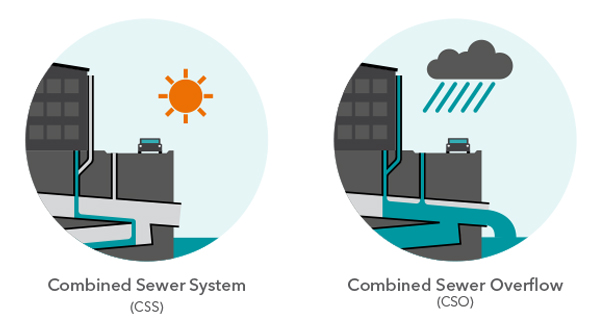
A CSO occurs during a heavy precipitation event, by design. It is preferable for the wastewater to go to the environment rather than into your coffee shop. But of course, the overflow route is carrying wastewater and its hypoxia-inducing nutrients and pathogens into the environment, causing things like harmful algal blooms, dead zones, and illnesses when humans are exposed to the waste.
The engineers of decades (or centuries) past hadn’t anticipated today’s more frequent heavy precipitation events, the densities of populations these systems would be expected to support, or therefore how often CSOs might happen. But today’s city engineers are finding new ways to address CSOs induced by stormwater, as we’ll see below.
Stormwater and Climate Change
One might surmise from daily media reports about more heat, more droughts, more wildfires, more floods, more hurricanes…that there is more stormwater. But are there data to support that? Maybe stormwater just seems like more of a problem because more of us live in cities now, with all of those concrete surfaces, combined sewer overflows (CSOs), and construction sites.
It is true that more of us live in urban environments today than ever before. In 2018, the UN reported that 55% of the world’s population lived in urban environments, and they projected that by 2050 that number would be 68%, following current trends. So both the population size and relative proportion of us exposed to urban stormwater have increased.
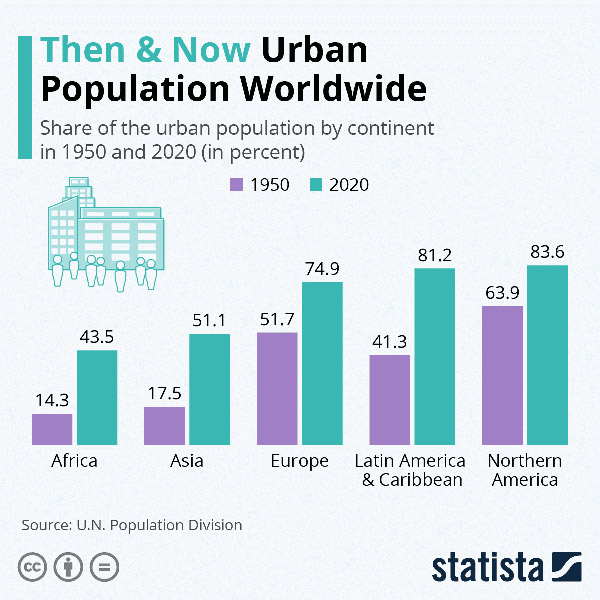
Image copied from https://www.weforum.org/agenda/2020/11/global-continent-urban-population-urbanisation-percent/.
Relative to rural areas of equivalent size, the challenge with cities is that there is a higher fraction of impervious surfaces: rooftops, parking lots, concrete structures, and so forth. It is widely accepted, through the use of data-based models like the USEPA’s Impervious Surface Growth Model, that when impervious cover in a watershed exceeds 25% there is a deterioration of water quality in that watershed. This is due, in part, to erosion and sedimentation that is facilitated by habitat degradation, and pollutants carried by the stormwater itself. Ultimately the runoff leads to decreased biological diversity and ecosystem “crashes.” So the effects of stormwater are not limited to the immediate area where the stormwater originated—they are felt throughout the watershed.
There is a positive feedback effect between cities, climate, and stormwater that goes beyond impervious surfaces: more people and more cities mean more greenhouse gas emissions, which contribute to rising global temperatures. As I mentioned in a recent webinar, a warming planet will lead to more precipitation, as detailed in the Sixth Assessment Report (AR6) on Climate Change, produced by Working Group I (WGI) of the UN’s Intergovernmental Panel on Climate Change (IPCC). The IPCC report is full of physical evidence, gathered from over 14,000 scientific publications combed through by over 230 of the world’s leading climate scientists, supporting the hypothesis of increasing frequency and intensity of precipitation events.
Figure 3 from the Summary for Policymakers from the AR6 shows changes in heavy precipitation that we are already seeing today, relative to the climate of the 1950s. Many parts of North America, Europe, and Asia are experiencing a significant increase in precipitation. Those events result in more stormwater. Managers of stormwater therefore would be wise to adapt their stormwater management plans to this reality of more people, in more cities, with more precipitation, and therefore more stormwater.
As such, stormwater management plans must now consider climate change, as it is felt both today and in the future, to build resilient systems. Below are three very effective ways that today’s managers are doing just that.
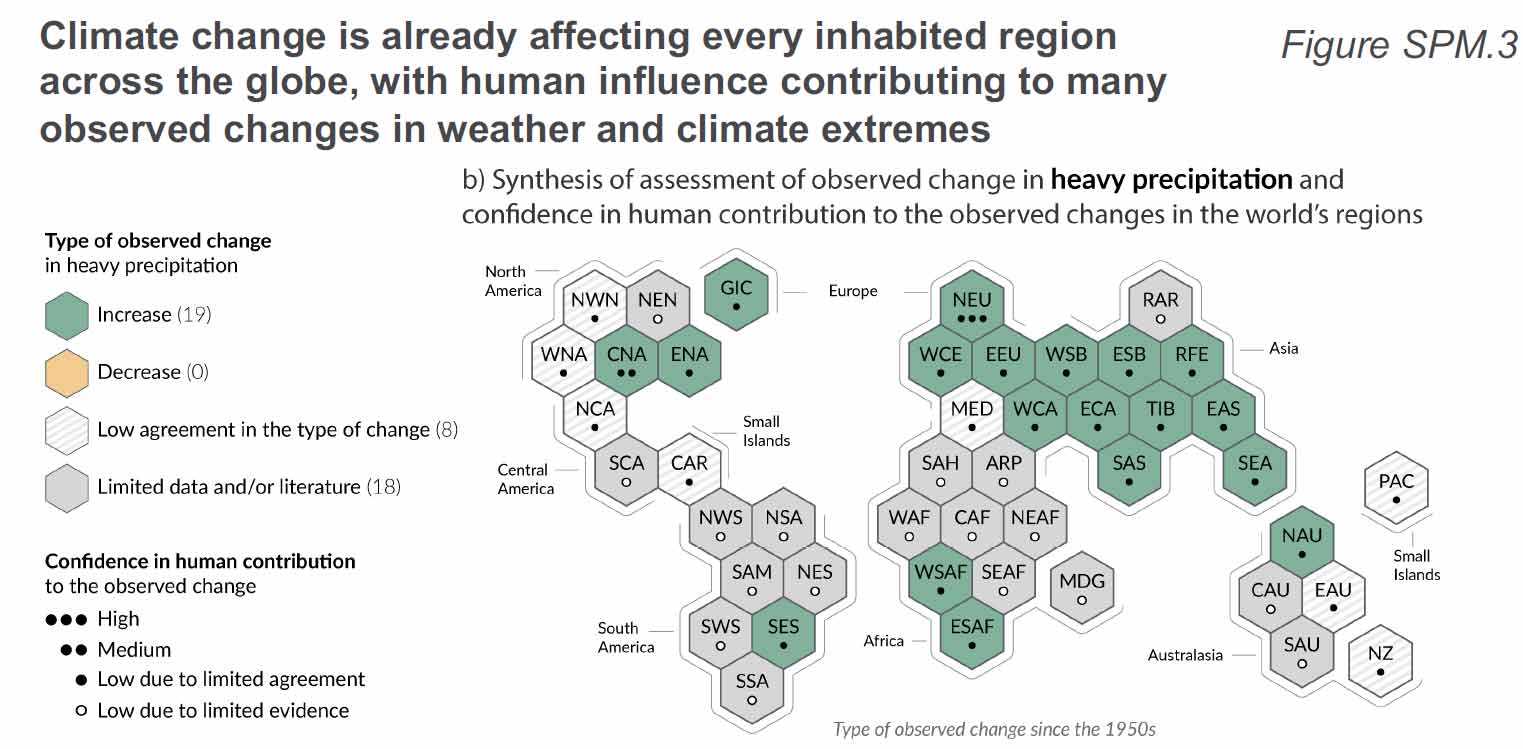
Stormwater Solution #1: Green Infrastructure
The USEPA has an entire suite of tools, information, and recommendations at their Climate Change Adaptation Resource Center, and this page has tools specifically geared towards water management. One can find fantastic case studies where these tools have been applied, and which offer a variety of strategies for adapting to climate change.
Something that almost all of the water case studies have in common is that they include, or are almost entirely based upon, green infrastructure. Not only can green infrastructure act as a carbon sink, but among its many benefits, green infrastructure is also an excellent strategy for absorbing and even partially treating stormwater.
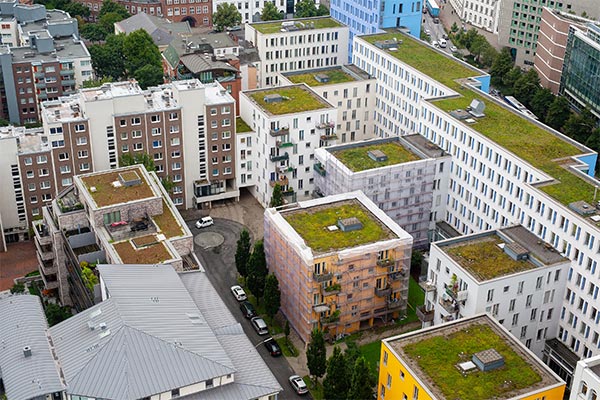
One of my favorite case studies is from the City of Camden, New Jersey. The Camden Stormwater Management and Resource Training (SMART) Initiative promotes equipping residents with rain barrels to collect and reuse stormwater, planting hundreds of trees, and building unique rain gardens and parks that all decrease the city’s relative impervious surface area.
Another part of the program includes cistern basins that catch stormwater for water for reuse. The basins are closely monitored for water inputs and withdrawals, and water quality. I talked about pressure transducers being used for groundwater monitoring in a blog from earlier in the year; the concept is identical for monitoring water levels in the cisterns. (Learn more, On the Level | Groundwater Measurements at High Altitude). Samples are collected from the cisterns for laboratory analyses of metals and other contaminants. These measurements not only help the city to know how the infrastructure is doing in reducing those pollutants but also in how the water can be reused.
An example of Camden’s success was almost immediately apparent when the program was young. Camden sits within the Cooper River watershed, a 50 square mile area of the inner coastal plain of southern NJ. Turbidity levels in the Cooper River could often exceed the state limit of 50 NTUs in the past. As my colleague Kerry Caslow taught us in an excellent webinar, turbidity is a sign that there has been the erosion of riverbanks and areas upstream of a water body, and also can be indicative of point source pollution events, like runoff from construction sites. (Learn more, YSI Webinar | How Turbidity Sensors Work). This 2018 report from the USEPA demonstrates that is no longer the case: Camden is absorbing and retaining more of its stormwater, so there are fewer pollutants, and less stream-eroding runoff leading to the Cooper River.
How Turbidity Sensors Work
Camden’s success has earned the US Water Alliance’s US Water Prize in 2019, and Camden is a model for programs in Philadelphia and elsewhere. They’ve had such good outcomes that the NJDEP has worked green infrastructure into new state regulations for stormwater management. An important part of their stormwater management program, and indeed of anybody’s, is to monitor the pollutants that are discharged with their stormwater. That brings us to our next adaptation to climate change, and that is continuous water quality monitoring.
Stormwater Solution #2: Continuous Water Quality Monitoring for TMDLs
TMDL, or Total Maximum Daily Load, is the amount of a specific pollutant that is allowed to enter a waterbody. TMDLs are usually set by states in the U.S., through their authorization by the USEPA to administer permitting under the National Pollutant Discharge Elimination System (NPDES). TMDLs are assigned to “impaired waters,” to help them become, well, unimpaired. This is all part of the Clean Water Act in the U.S.
Actually setting a TMDL can be a tricky business, though. The basic approach is that the EPA, or a state it authorizes, will determine a loading capacity that a waterbody can hold for a specific pollutant. It then determines who discharges that pollutant (cities, industries, or other parties), and each contributor is assigned an allocation for the pollutant that becomes the threshold on their NPDES permit. Alternatively, someone who is preparing to discharge to an impaired river (and really any river) must contact their state authorities to determine whether they need a permit. The allocations are usually set with a reduction of total loading in mind so that the water body can in the long run recover from its impaired state.
Imagine the consequences for a stormwater manager if those TMDLs are not based on sound data. That’s exactly what has happened in some cases when well-meaning states have had to rely upon intermittent grab samples for estimating the pollutant capacities. These snapshots of pollutant concentrations can result in TMDLs that are based on inaccurate data.
One possible consequence of those inaccuracies is setting TMDLs too low. As climate change drives more discharge events, it becomes more likely that there will be permit violations, and that adds up to fines and other consequences. Nobody wants to impair a water body, but nobody wants to pay for something that isn’t actually impairing that water body, either.
Adaptation to climate change thus should include a continuous monitoring program that 1) helps to set TMDLs, and 2) helps to assess the discharge-associated loads for compliance with NPDES permits.
Woolpert, Inc. is an architecture, engineering, and geospatial firm with deep expertise in stormwater, NPDES permits, and TMDLs. They have designed stormwater management programs with both of the above objectives in mind. The monitoring stations often employ YSI’s water quality sondes and SonTek’s IQ Doppler profilers for assessing flow, as discussed in a recent webinar. (Learn more, Webinar | Why Collect Water Quality Data When All You Need is Flow (or Vice Versa!)).
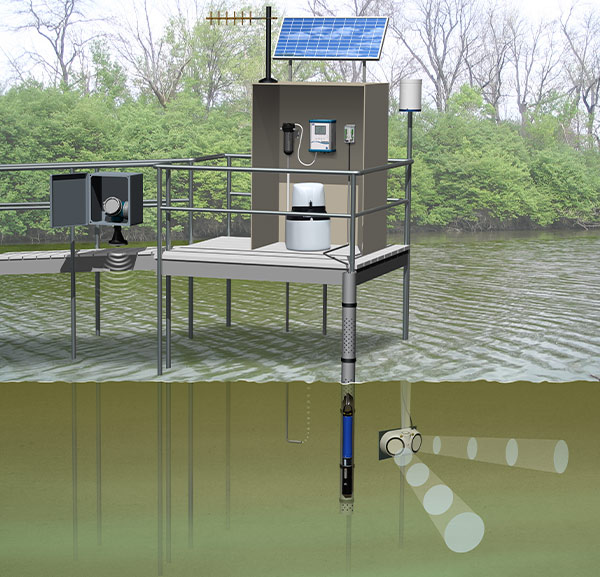
A great Woolpert-YSI success story where continuous monitoring helped with TMDLs and long-term stormwater resiliency comes from Columbia, South Carolina. As described in this American Public Works Association article and an earlier YSI application note, Columbia faced the very challenge described above, where potentially inaccurate grab sample data had been used to set TMDLs. They worked with Woolpert to set up monitoring, and then to develop data-driven models that helped them to work with the state on TMDLs and their permits. This system is not just helping them to stay in compliance; it is also helping them to assess the impacts of new management strategies.
And that actually brings us to our third stormwater solution for climate change—building models that will ultimately help one to build resilience.
Stormwater Solution #3: Modeling
In a prior YSI blog, we described how the South Florida Water Management District (SFWMD) used climate change models in their planning to adapt to sea level rise. The SFWMD uses models to identify vulnerabilities and what infrastructure investments they might make. For example, the region is known for its intricate system of canals—enlarging some of the canals might increase the capacity for absorbing water from events like hurricanes.

In a manner of speaking, adapting to any future scenario means asking the question, “What would happen if…?” If one has sufficient data, a model can be built to predict the answer to that question. The model can also reveal opportunities for changing that answer to one that is more desirable, and those opportunities can form the basis of a strategy. The SFWMD takes just that approach, and has one of the most sophisticated modeling groups in any state government, with dozens of reports and publications to demonstrate the power of modeling for the management of water in the District.
One problem the SFWMD’s models help them manage is stormwater-facilitated delivery of nutrients into Lake Okeechobee. Lake Okeechobee is one of the most important resources in the state, and stormwater in the rich agricultural region can deliver heavy loads of phosphorus into the Lake, stimulating Harmful Algal Blooms. The climate change-stormwater-HAB cascade is pretty well understood by those that study the Lake, and especially by those living in the area and dealing with the blooms.

The SFWMD oversees a vast system of Stormwater Treatment Areas (STAs), which include things like constructed wetlands and reservoirs to both hold stormwater and divert stormwater flow through areas where some of the nutrients can be absorbed. The Taylor Creek STA is one such system that diverts nutrients before they ultimately reach Lake Okeechobee. Modeling plays a role in the design and management of the STAs, as can be seen by the numerous reports the SFWMD modeling group has produced about the STAs.
An important point about modeling is that it is so accessible these days. One can find SFWMD’s modeling documentation and even a software application, and modeling projects can be submitted so that their expertise can be accessed. The EPA’s Climate Change Adaptation Resource Center mentioned earlier is also a place where one can access modeling tools and even some support in learning how to use them. Universities have data science labs that frequently collaborate with the private and public sectors to help build models that can drive decision-making.
No matter where one finds it, stormwater managers are well-advised to use models to help them adapt their systems and strategies to the future; a future that will be shaped by climate change.
